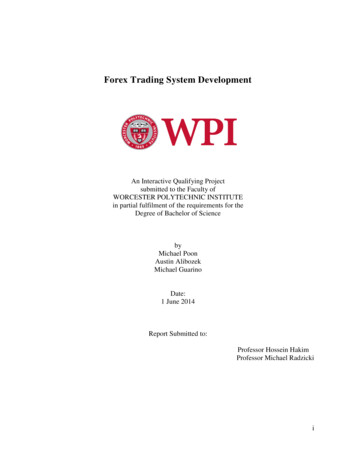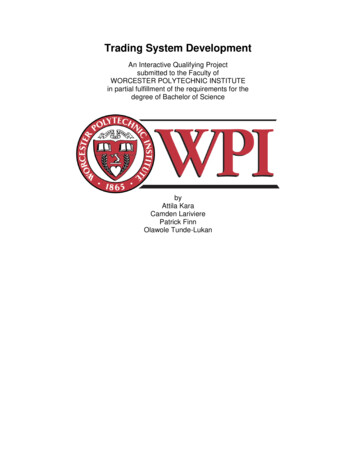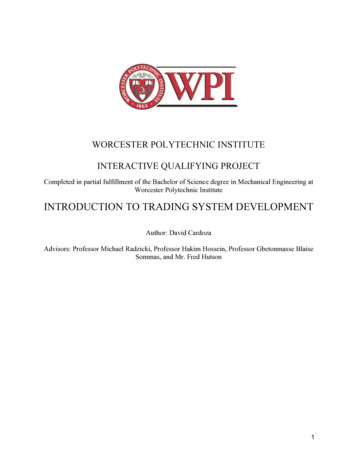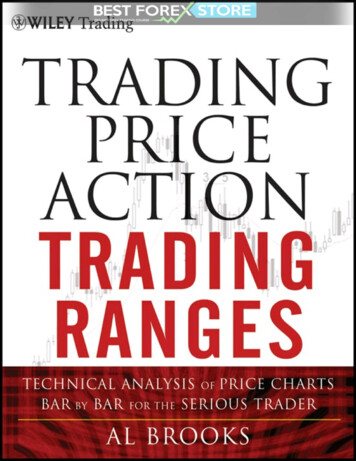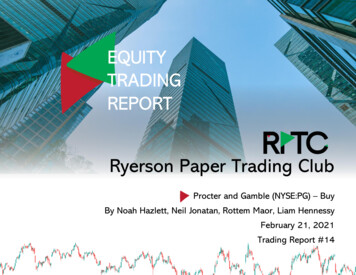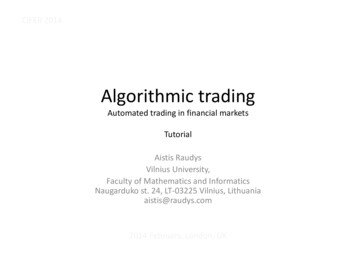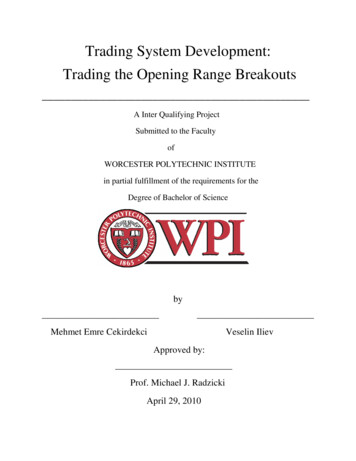
Transcription
Trading System Development:Trading the Opening Range BreakoutsA Inter Qualifying ProjectSubmitted to the FacultyofWORCESTER POLYTECHNIC INSTITUTEin partial fulfillment of the requirements for theDegree of Bachelor of SciencebyMehmet Emre CekirdekciVeselin IlievApproved by:Prof. Michael J. RadzickiApril 29, 2010
ContentsAbstract . 4Acknowledgements. 51Introduction . 62Background . 82.1Fundamental Analysis . 82.1.12.2Technical Analysis . 92.2.1Reading Charts . 112.2.2Price vs. Volume Relationship . 122.2.3Support and Resistance . 132.3The Opening Range . 142.3.1Principles of the Opening Range . 152.3.2Breakouts & Breakdowns . 162.3.3Fading the Opening Range . 182.4What have others done?. 182.5Profile of a Complete Trading Strategy . 192.5.1Set-up . 192.5.2Entry . 202.5.3Exit with Profit. 212.5.4Money Management Stop (Exit with Loss) . 222.5.5Position Sizing . 232.6System Testing . 232.6.1Backtesting . 232.6.2Optimization. 242.73Problems with Fundamental Analysis . 9Tradestation . 24Creating the Actual OR Strategy . 253.1Basic Opening Range Breakout Strategy . 253.2Entry Strategy: Set-ups & Triggers . 293.2.1Yesterday’s Values: Buy Easier Day & Sell Easier Day . 303.2.2Simple & Exponential Moving Average . 303.2.3The Inside Bar. 34
3.2.43.34Volume . 35Exits . 393.3.1End of the Day Exit . 403.3.2Percentage Trailing . 413.3.3ATR Ratchet . 423.3.4RSI Overbought & Oversold . 433.3.5Money Management Stop 1: Opening Range High & Low . 453.3.6Money Management Stop 2: V-Box . 48Back Testing and Results . 504.1Results for the Basic Opening Range Breakout Strategy . 504.2Testing Entries. 524.2.1Results for Buy Easier & Sell Easier Day Filter. 524.2.2Results for the Inside Bar Filter . 534.2.3Results for Exponential Moving Average Indicator. 554.2.4Results for Volume Indicator . 564.3Determining the Final Set-up . 574.4Testing Profit-Making Exits . 574.5Testing Money Management Stops . 594.6Final Strategy & Overall Results . 625Conclusion . 656Next Steps . 667Bibliography . 678Appendix . 698.1Backtesting Results for Profit Making Exits . 698.2Backtesting Results for OR High & Low Money Management Stop . 738.3Backtesting Results for V-Box Money Management Stop . 778.4Backtesting Results for Exponential Moving Average Indicator . 828.5Basic Opening Range Breakout Strategy: Easy Language Code . 828.6Final OR Strategy: Easy Language Code . 858.7ATR Ratchet Long Exit - Easy Language Code: . 928.8ATR Ratchet Short Exit - Easy Language Code . 93
AbstractThe goal of this project is to identify various set-ups and exit strategies that could be usedfor trading the 30-minute Opening Range breakouts. The project team created a technical tradingsystem using the TradeStation platform and backtested it over 250 stocks from different industrysectors. Twenty two stocks were identified that performed significantly well and details abouttheir performances with various conditions were provided.
AcknowledgementsWe would like to extend our thanks to Professor Michael J. Radzicki for his continuoussupport and help throughout this project. We also would like to thank Geoff Bysshe for sharinghis knowledge about the Opening Range in his book “Trading the 10 O‟clock Bulls” whichhelped us develop an Opening Range Breakout Strategy.
1 IntroductionThis project is primarily focused on a popular trading principle called the Opening Range(OR). In his book “Trading the 10 O‟clock Bulls” (Bysshe, Trading the 10 O'clock Bulls, 2004)which is referred to numerous times throughout this project, Geoff Bysshe defines the OpeningRange as the first X number of minutes of a trading day. The number of minutes used to definethe Opening Range is up to the trader. In this project, the Opening Range is defined as the first30 minutes of the trading day.What makes the 30-minute Opening Range a powerful concept in trading is that it is theperiod during which traders act in response to recent news and observe the initial pricemovements of a particular stock with respect to the analysis they have done since the close of theprior day. The fact that important economic reports are often announced at 10:00 am contributesto the significance of this period and makes it informationally rich.Geoff Bysshe also claims that about 35% of the time, the high and the low prices for theday occur within the first 30 minutes. This means that it is very likely that a stock will continuetrading within the Opening Range and if its price breaks out it will continue to move in thedirection of the breakout.Even though the OR is used very frequently by traders and acknowledged as a powerfulconcept, there is no widely available information regarding how to create an automated OpeningRange Breakout strategy. The majority of the literature and studies on trading the OpeningRange breakouts give suggestions with very few real examples and are better suited for manualtrading.
The purpose of this project is to identify possible set of set-ups and exits that are suitablefor trading the 30-minute Opening Range breakouts. Using the TradeStation trading platform, theproject team tested 4 different set-ups and 4 profit making exits as well as 2 money managementstops on 250 stocks from various industry sectors. The set-ups tested include “Buy easier & Selleasier day, the inside bar, simple and exponential moving average, and volume. Profit makingexits tested consist of “the End of the Day exit, Percent trailing exit, ATR Ratchet, and RSIOverbought/Oversold exit” Each set-up was first backtested with the most universal of the 4exits mentioned above, the end of the day exit, over 5 years (4/21/2005 to 4/21/210). Thecombination of Buy easier & Sell easier day and volume indicator was identified to yield the bestresults compared to the other set-ups tested. This set-up was then tested with the other exitstrategies over the same time period. The results obtained showed that the End of the Day exitgenerated higher profits due to significant price movements occurring in the last hours of thetrading day.The next sections will introduce you to the concept of the 30-minute Opening Range andcomponents of complete trading strategies. Subsequently, entry and exit strategies tested will beexplained and results will be shown.
2 Background2.1 Fundamental AnalysisThere are two main stock trading methodologies used by traders. Fundamental analysis isan analytical approach which attempts to determine a stock‟s intrinsic (real) value by examiningrevenue, earnings, expenses, assets, liabilities and other financial aspects of a company. Theoverall state of the economy, competition, effectiveness of the management and other factors thatcould affect a company‟s business are also investigated by fundamentalists to determine whetheran investment opportunity exists.Fundamental analysis is based on the theory that the market price of a stock willeventually gravitate towards its intrinsic value. Therefore, if the intrinsic value of a stock ishigher than its market price, fundamental analysts believe that it is a good opportunity to buy. Incontrast, if the intrinsic value of a stock is below its market price, it is recommended thatinvestors should short it. While typically used to determine the value of a company‟s stock,fundamental analysis can also be applied to other securities such as bonds and currency. It shouldalso be noted that determining the real value of a stock is not always as easy as it sounds.Oftentimes professionals do not agree on the real value of a company‟s stock.Listed below are some of the measurements used by fundamental analysts regardingvalue investing: Earnings per Share (EPS) Price to Earnings Ratio (P/E) Price to Sales Ratio (P/S) Price to Book Ratio (P/B) Projected
Market action discounts everything: Technical analysts believe that all the factors (e.g. fundamental factors, overall state of the economy, social or political factors) that influence companies are already reflected by the stocks‟ prices, thus making it redundant to analyze all

